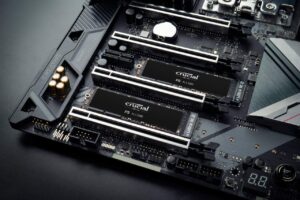
SSD Buying Guide
An SSD is one of the options you have for the storage drive in your pc.
It stands for Solid-state drive and due to the way it accesses the data an SSD is able to read and write data much faster than a mechanical hard drive (HDD) as you may hear it referred to as SSD access data much faster, this, in turn, improves your computers overall performance like your operating system, games, images, and music with nearly instant boots and load times because they don’t have a mechanically seek out on spinning platters as HHD does.
In this buying guide, we will run through the different kinds of SSDs you can get and what you need to consider weren’t buying your next one. SSDs these days come in several different form factors and operate across several possible hardware and software connections.
What kind of drive you need depends on what device you have or intend on buying. If you own a recent gaming desktop or you are building a PC with a recent mid to high-end motherboard your system may be able to incorporate most or all moderns types of drives.
So now let’s start by taking a look at the different connections type of internal SSDs.
- SATA 2.5" SSD
- M.2 SATA SSD
- M.2 NVMe PCIe SSD
SATA is standard for connecting and transferring data from hard disk drives to computer systems. All current spinning hard drives connect your computer over the SATA port which is located on your computer’s motherboard. The maximum transfer speed supported by SATA 3 is 6 GB/s. A SATA 2.5” SSDs use the SATA connector and can be up to 3x to 5x times faster than a regular spinning hard drive(HDD). These can be installed on both Laptops and Desktops.

The connector allows connecting much faster SSDs in comparison to the SATA connector. It is much smaller than 2.5” SATA SSDs and can also be 3x to 5x times faster than HDD. It can be installed in both laptops and desktops that have compatible M.2 connector, and Now the M.2 connector either supports SATA or PCIe. Sometimes the M.2 connector can support both SATA and PCIe.

M.2 NVMe PCIe SSDs- This type of SSDs capable of transfer up to 40 GB/s which is almost 7x faster than SATA SSDs. The M.2 NVMe PCIe SSDs can also be installed on both laptops and desktops which have a compatible M.2 connector.

Now, we will help to identify what kind of SSDs compatible with your laptop or desktop based on one of the three following scenarios.
1. Replace your old spinning hard drive with SSDs- All laptop manufacturers in the last 5-7 years will have a SATA 3 connector and will usually have 2.5” internal hard drives connected to this. This 2.5” internal hard drive can easily be replaced with any 2.5” SATA SSDs. All you have to do is literally swap out the old hard drive with the new SATA SSDs. this works the same works both in laptops and desktops.
2. Adding an SSD without removing your old HDD- You don’t want to get rid of the old hard disk but you want to add SATA SSD to your system so the boots faster. Apart from adding the SSD to the SATA port, you can also add M.2 SSDs to the M.2 port instead. DO not the M.2 ports can support both SATA 3 SSDs and faster M.2 NVMe SSDs however sometimes they only support one or the other.
How to check whether your M.2 ports support M.2 SATA SSDs, M.2 NVMe SSDs, or both.
Step1. check the specifications page of the desktop/ laptop motherboard.
Step2. Check the user or service manual for M.2 storage compatibility
Step3. If after checking the specifications page, and the user and service manuals, you still don’t find M.2 storage compatibility information, then reach out to the manufactures service center and ask for this informations.
3. Upgrading your M.2 SSD- Now if your system already shipped on M.2 drive you gonna find upgrading either easy once again the SATA 3 VS NVMe might rise but you can use a tool called “crystaldiskinfo.com” to determine whether the M.2 port runs on SATA or PCIe NVMe. You can download this tool from crystaldiskinfo.com and once installed very first scene will give you all the information you need, when you run the tool look for the Interface setting in the window this will either be NVMe or Serial ATA reveling the kind of drive of laptop or desktop currently has run. If you have multiple drives installed you can look up your information all of their connectors as well. Now based on Interface type you can now go ahead and purchase an SSD with the same interface, making the replacement easy.
If you already have SATA M.2 SSD and want to know if you can upgrade to M.2 NVMe PCIe SSD just follow the same process Step 1,2, and 3.
We hope you are now more comfortable choosing an SSD that is compatible with your computer laptop and desktop.
DISCLAIMER:
- Upgrading desktop or laptop components requires skill and patience. Please research your machine, especially the compatibility of 3rd party component before trying to install them.
- We have left out PCIe Gen4 SSDs. this is because this is a new PCIe standard which is supported by a very limited number of desktop motherboards only.
- We suggest you take help from an expert when installing an SSD in case you do not have experience doing it yourself.
